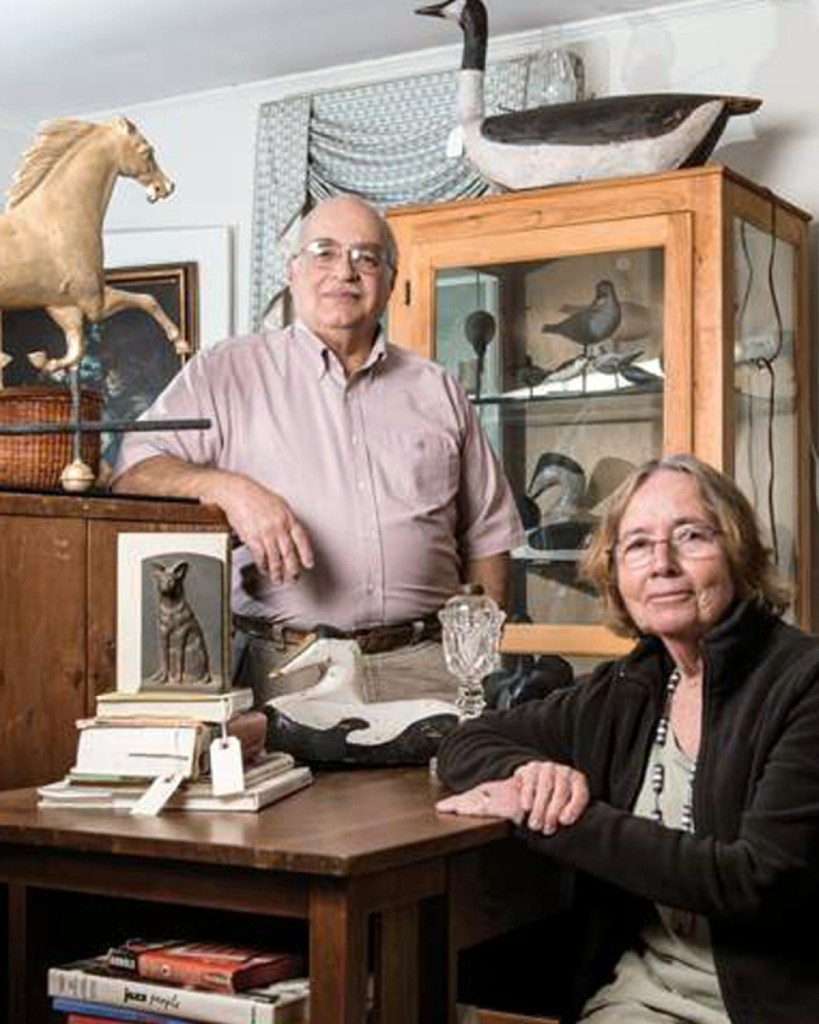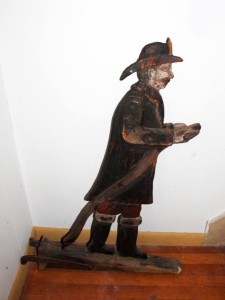
John and Liz DeSimone, for the last 40 years or so, have been producing ten to 12 antique shows annually in New England and, until recently when their landlord sold the property, operated an antique shop on Route 1 in Wells, Maine. Their shows originally leaned towards country Americana; now their dealer mix is broad with quality dealers in various fields so you never know what may turn up. They met when both were attending Colby College in Waterville, Maine, and married in 1968. John taught at the high school level and his interest in antiques was a result of his friendship with a fellow teacher. Liz grew up in a house filled with antiques with parents who introduced her to “old” things. Together, their interest in antiques developed and both recall that their first purchase was a Windsor chair. “We’re especially interested in antiques made in Maine,” they said.
How did the business begin?
We loved early furniture, especially pieces in old paint. But between us, in the beginning, we were earning $98 a week. After paying our bills, we had about $7 a month left for antiques. So, it was obvious that we had to start selling. We opened our first shop and then decided to start doing shows. We began selling at shows with the Mal French (later Sarah French) shows at the New Hampshire Highway Hotel and then Sonia Paine’s shows in the Boston area. Weekends were spent at auctions and “antiquing.” Those were really fun days. The shop in Wells was open about 20 years and it had been perfect for us, right on Route 1.
When did you start producing shows?
Our first one was at the Westbrook Academy, in 1972. We had seen that there weren’t many shows where young dealers could exhibit, so we felt there was a niche for us. Many of the dealers who did some of those early shows are still with us and we’ve become good friends with a lot of them. Now we’re running ten or 12 shows a year. It was really a family enterprise in the early years. Our kids grew up in the business, helping in many ways and they were porters at shows in those days. All our shows are in New England: Maine, Massachusetts and Connecticut. By the time we thought about Antiques Week in New Hampshire, it seemed to us that there were enough shows, so we never tried that time slot. We’ve been running the Kennebunk show for more than 40 years and the Camden, Maine, show for about 37 years.
You’ve recently revived one of Maine’s largest indoor shows?
Yes, two years ago we started our show in Portland. It has 65 dealers and we’re just about sold out for this year. The Maine Antiques Dealers Association used to run shows in the Portland area, but they haven’t for a while. We thought there would be a market in Portland, and it worked. The crowd was larger last year than the first, and we hope it will be larger again this year. The show is scheduled in September when many of the folks with second homes in Maine are still in the area.
What changes are you seeing in the business?
Like everyone else, we’re seeing that some things, like good early formal furniture, aren’t selling the way they did. That tells us to broaden the type of dealers at our shows. It was once pretty much all country, but now we’re including dealers who concentrate on midcentury objects and other specialty areas. And like everyone else, we want to attract younger buyers, so we’re learning to take advantage of the internet. Each show has its own Facebook page with lots of photos. Instagram is next; we know many of the people we’d like to attract are on Instagram. Keeping up with the internet is time consuming but necessary. As effective as the internet is, we still use snail mail and send out thousands of mailers for each show. Each has a $1 discount coupon so we’re able to see what works and what doesn’t. We also advertise in many of the small, local newspapers, again with discount coupons so we know what works. It helps us attract family shoppers as well as those stopping in the area for a few days. We put out hundreds of show cards in antique shops, motels and restaurants, as well as other businesses near our shows and elsewhere in the neighborhoods.
There’s a good story with the fireman, isn’t there?
It’s one of our favorite folk art signs in our collection. Around 1974 an exhibitor brought this fireman sign, which he had purchased from a volunteer fire department in upstate New York. A Maine dealer, Millie Peladeau, bought it, and when we saw it in her booth, we asked her the price. She said it was $300. At the time we were only making about $110 a week teaching, so we decided that we couldn’t afford it. We did tell her that it was great, and we thought it was the best piece of folk art in the show. We couldn’t believe that she was selling it that cheaply. We said so much, that we convinced her. When the doors opened, another Maine dealer was considering buying it and was on the phone with her husband. We decided that we would buy it anyway and figure out where the money would come from later. When we approached Millie to buy it, she apologized and said she had taken our advice, put a price of $700 on it, and was waiting to hear from this dealer. If we wanted it, we would have to pay the $700 that she was sure she was going to get. It killed us, but we did it; and we have been pleased ever since. But we did learn a lesson – keep our thoughts to ourselves from now on. No regrets though.
-Rick Russack


